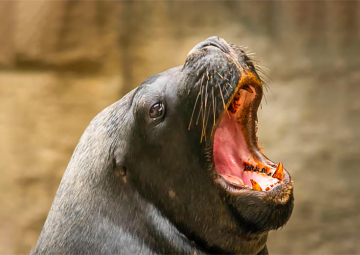GENERAL
Routine health check training with polar bears

My name is Kim Wilkins and my animal training career began in 2007 when I joined the animal presentations team at Bristol Zoo, training display animals for the educational shows. I then moved to Onmega dolphin therapie in Marmaris Turkey and trained dolphins for public interactions and dolphin-assisted therapy.
My current role is as the carnivore team leader at Yorkshire Wildlife Park. I also hold the position of co-chair for the BIAZA (British and Irish Association of Zoos and Aquariums)
Animal Behaviour and training working group and sit on the polar bear EEP husbandry and welfare committee. Yorkshire Wildlife Park is home to 8 polar bears (Ursus maritimus), 3 juvenille males and 1 fully grown male who reside at the Project polar complex and we have recently been joined by 1 adult female and three, 20 month old cubs at the Project Polar 2 complex which is located at the opposite side of the park. The Project polar complex has an excellent range of training facilities such as a small foot sleeve, a larger combined head/foot sleeve which enables x-rays to be taken and for veterinary checks and treatment of the ears, eyes and mouth and a back foot access sleeve. The training of routine healthcare procedures is an essential part of any husbandry regime. It enables a high level of animal husbandry, disease control and/or prevention and increased animal welfare.
Perhaps one of the most important reasons for a healthcare training regime is the decreased need for anaesthesia, which is never without its risks. The adult male polar bear, Luka weighs in at 560kgs, an anaesthesia for an animal this size is potentially dangerous and extremely stressful for the bear and the care team and so any efforts to reduce the need for sedation are strongly encouraged. The carnivore team at Yorkshire wildlife park have trained the collection’s 4 male polar bears for multiple healthcare procedures to aid in diagnosing lameness, treating eye infections, performing conscious head and foot x-rays, voluntary injections, topical cream application and foot examinations.
All these have led to a more rapid diagnosis and treatment period, benefitting the bears and aiding the reduction of veterinary costs and recovery time for the animals.
X-ray training for hear and feet
A multi-purpose sleeve was installed in the indoor den area of the polar bear house. It could be placed in the head or foot position and can be used for ear/eye care or head x-rays. It can be moved to the foot position and used for foot x-rays.

Fig 1.
The sleeve above is interchangeable between the two positions so that it can be utilised for both head and foot exams. The top and bottom slides of the sleeve can be removed and replaced with Perspex for x-ray purposes as shown below.

Fig 2.


Fig 3 - 4 Head x-ray

Fig 5.
The training taking place in this picture was for a research project that involved shaving the same patch of hair once a month to measure cortisol levels. This study took place over the period of around a year. We utilised this behaviour to begin jugular blood draw training also.
Establishing the behaviours:
We began the training by allowing the bears to become desensitised to the sleeve. They have free access to their indoor areas throughout the day as routine but initial access to the sleeve were supervised however the team could quickly allow the bears to have access to the sleeve with no keeper present.
Once the bears were used to seeing the sleeve, we trained for the head present first. We bait trained the bears first, offering the reinforcer at the end of the sleeve so that they put their head in it to get the reinforcer. In order to get more control of the behaviour we introduced a target at the end of the sleeve then bridged and reinforced. Reinforcers were cod liver oil (delivered in a spray or squeezy bottle), whipped cream, canned sardines or fruit. Sessions took place during normal husbandry routine and were typically 5-10 minutes in duration. Due time constraints and equipment availability, the bears were not exposed to the x-ray equipment before the procedure, but the behaviour was so strong it made no difference to the bears. Eye and ear examinations were trained after the head present was established.
{youtube}https://youtu.be/eOYbXCxKFwI{/youtube}
The foot present behaviour was trained using target training. A target with a blue ball on the end was placed into the sleeve at the ‘foot’ position. When the bears put their foot in the sleeve on presentation of the target, they were bridged and reinforced. When the initial present was established, the team introduced the cue, which was a double hand tap on the top of the sleeve. When the bears were responding well to the cue, the team introduced a secondary ‘hold’ cue to ask the bear to hold the foot in position until bridged (see Fig 3).
This was achieved by implementing a very small delay on the bridge when the foot was presented in the sleeve when the first cue was given and gradually increasing the delay in introducing the ‘hold’ signal at the same time.
A secondary foot sleeve was installed for more intricate work on the front feet. The foot present into this sleeve was trained in the same way as foot present in the larger sleeve.
Tips for training large carnivores:
-
Always ensure that a coherent risk assessment protocol is in place before training commences.
-
If new a training aid has been installed, allow an appropriate amount of time for the animal to become desensitised to it.
-
Using a variety/quantity of high value reinforcers will help to establish the behaviours promptly and keep the animal engaged in the session.
-
Try to resist asking for ‘just one more time’. If the animal does as you’ve asked and to the required criteria, bridge reinforce and move on. The animal may well become frustrated or disengaged if it is asked to repeat a behaviour too many times.
Problems encountered:
-
The bears quickly learned that the sleeves were a place where they could be highly reinforced and as a result, the bears showed some aggression around them. This was managed out by reinforcing the bears for sitting calmly in the house away from the sleeves.
-
Sometimes, more than one trainer was required in order to make sure that when one animal was being trained, the other bears were being reinforced for waiting patiently. This could be an issue if staffing was limited.
The training will now focus on foot care of the back feet through a specially designed slide to aid foot care for the polar bears. It has become apparent that foot problems are quite a common occurrence within the EEP so this type of training will be imperative in early detection and prevention of foot abscesses in the future.
I would like to extend my gratitude to the team at Wezooit for the opportunity to share our work with you.
And remember, if it’s possible…WeZooit!
SHARE
For any questions, contact us.


















